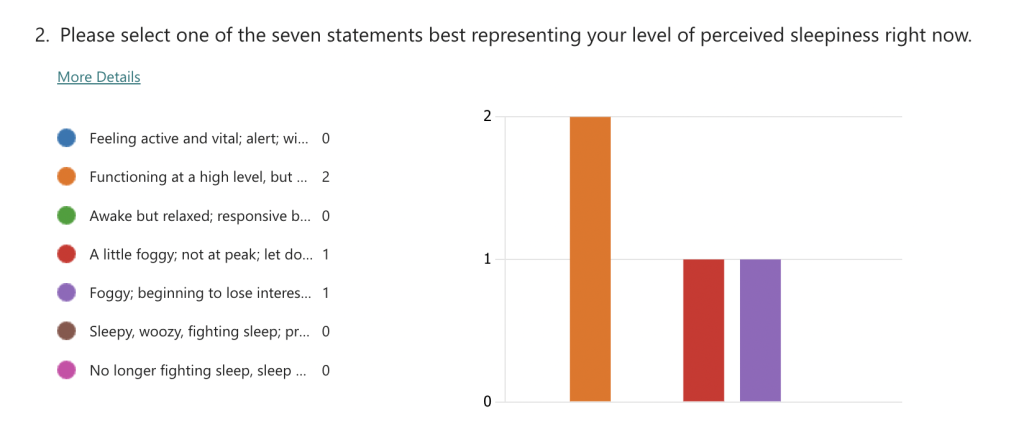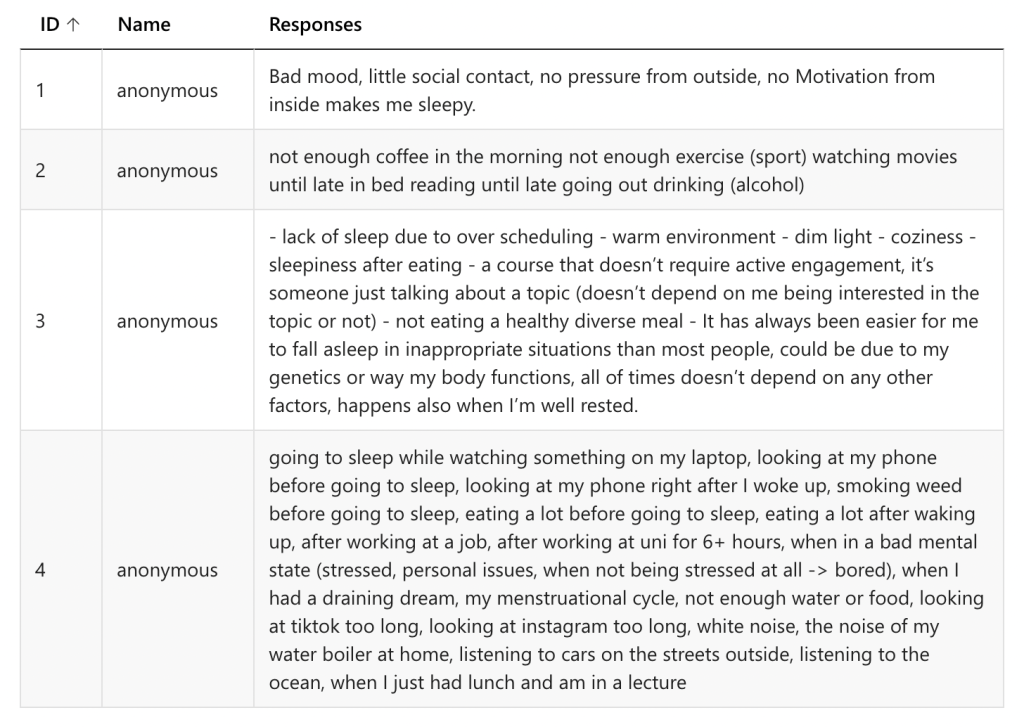To investigate how the level of sleepiness in students affects their learning experience I made use of two methods: a questionnaire on Microsoft forms and a collective writing activity making an Exquisit Corpse. Unfortunately only four students participated – but nevertheless the responses to the form give an idea of the general levels of sleepiness in the classroom on 19 December 2023, a few days before Christmas and the last day before the winter break.
Level of sleepiness among students
In terms of the momentary, subjective levels of sleepiness according to the Stanford Sleepiness Scale (Hoddes et.al., 1973) two out of four students feel like they are functioning at high levels, thus not at peak, while one student feels a little foggy and another one foggy, loosing interest in remaining awake.

The Epworth Sleepiness Scale (Johns, 1991) requires adding up the responses to each answer, giving a value on a scale of 0 to 24. A value between 0 and 7 signals that it is unlikely that the respondent is abnormally sleepy. A value of 8 or 9 signals an average amount of daytime sleepiness. A score of 10 to 15 hints that the respondent might be excessively sleepy depending on the situation. And a score between 16 and 24 suggests that the respondent is excessively sleepy and should consider medical attention.
Calculating the scores for each respondent (1: 11; 2: 8; 3: 16; 4: 5) shows that two out of the four show average levels of daytime sleepiness while two students are excessively sleepy. I don’t think it is my place to tell the student to seek medical attention but being aware of the detrimental effects on cognitive functioning of little sleep and sleepiness this proofs that my investigation is worthwhile and sleepiness could be considered when planning for education.
Level of sleepiness during the academic year
Asking students to rank the times during an academic year from when they feel sleepiest to when they feel most awake does not provide a representative result since only four students participated, it shows, however, a trend that students feel most sleepy during the winter semester and winter break and “wake up” during spring and summer. It might be worth investigating this further, with a larger cohort of students and during different times of the year. Potentially this could aid in planning the workload accordingly, asking for example for larger assignments during the summer semester than during the winter semester.

Factors contributing to student sleepiness
The last question on the questionnaire asked the students to list all things they consider contributing to them feeling tired or sleepy. You can view all responses in Figure 3, but after grouping the responses into themes four categories stand out: Mood, Consumption, Screen Time and Environmental factors.
A bad mood because of too much or too little stimulation like boredom or stress can lead to feeling sleepy. Sleepiness is also affected by drinking alcohol, not enough coffee or liquids, not eating healthy or eating too much or too little but also smoking weed before going to sleep. Screen time like watching movies or looking at the phone for too long before sleep also increases sleepiness. Lastly, environmental factors such as room temperature, low light and white noise can also contribute to feeling more sleepy.

Narrative analysis of collective fictions
Before analysing the collective fictions written by hand in the format of an exquisit corpse I translated the stories from German into English. A scan of the original fictions can be viewed in the ARP Action blog post and the translation in blogpost on fictions on sleepiness in the classroom. The fictions are written from a first person perspective to elicit an expression of feelings. The collective writing activity was chosen so that the students don’t only to draw from their personal experience but imagine a fictional character while remaining anonymous.
Factors contributing to students’ feeling of sleepiness in the classroom were similar to the responses in the last question in the questionnaire (Mood, Consumption, Screen time and Environment) and thus those categories were used as a thematic framework for analysing the results. Two more themes emerged in resonance with the word list from the questionnaire: Work and Exercise.
Mood
… I can’t think of anything else than you and keep getting lost in my thoughts.
Anecdote 7
The students describe that them feeling bored or stressed both has an impact on their sleep quality and in turn also on their level of tiredness in the classroom. Depending on how interested they are in a given topic and how engaging the delivery of content is they then describe how they can or cannot stay focused.
Showing signs of sleepiness such as yawning or even falling asleep is described as uncomfortable or awkward.
Consumption
… I was longing for an oat milk cappuccino with a cookie. This is normally my best way to wake me up; the small sugar rush always takes me out of my brain fog. I started dreaming myself into a small cloud made from oat milk foam. Floating along the oat milk sea on a raft made out of cookie material. The surface below me turned soft and I swam into a vortex, like Tim from the Kaba advert swam down a chocolate vortex. Yummy and extremely pleasant. I could remain here forever.
Anecdote 3
Both in the questionnaire and the anecdotes there are multiple references to consuming food, drinks or other substances. Both eating too much or too little can lead to feeling tired. Particularly a lecture in the morning without coffee or breakfast or a lecture after lunch are mentioned several times as being difficult to remain focused and alert.
Several anecdotes allude to a desire for food such as an oat milk cappuccino and cookie, veal sausage and pretzel (a breakfast in Bavaria) or hot chocolate. The seminar is taking place in the morning from 10am – 12:30pm.
Drinking too much alcohol or smoking weed in the evening is also mentioned as leading to sleepiness the next morning.
Screen Time
Sitting too close to the screen means looking at one pixel for the whole time, that appears much bigger than intended.
Anecdote 1
Watching films or looking at the phone for long until falling asleep or first thing in the morning are considered bad for the level of alertness and awakeness the next day. This trope is picked up in the anecdote where sitting too close to the screen in the classroom can also lead to feeling sleepy.
Environment
The humming of the beamer mixes with the flickering of the image. The blue light from outside with the warm light insight. I feel like Cher in her new Christmas song DJ Play a Christmas Song where she sings “It’s cold outside but it’s warm in here”.
Anecdote 1
The environment of the classroom has an effect on the level of sleepiness. Dim light, warmth and white noise such as the humming of the beamer can be sleep-inducing. Loud, unexpected sounds in contrast, can function as a way to wake up.
Work
I peacefully fell asleep without noticing, since my dream was about work. It was about a staircase, it was spiralling up and down and eventually in my dream I started drilling and bending. I think I’m studying too much.
Anecdote 8
Working a lot can lead to feeling sleepy but also impacts the sleep quality – too much work leads to stress and thus sleeplessness and tiredness in the classroom.
Exercise
I take three deep breaths in and out; I stretch my head and my arms and finally focus on the seminar.
Anecdote 7
Physical exercise, particularly a lack thereof, is mentioned as leading to feeling sleepier. In two anecdotes moving the body can help to wake up and increase focus.
References
Hoddes E, Zarcone V, Smythe H, Phillips R, Dement WC. 1973. Quantification of sleepiness: a new approach. Psychophysiology, 1973; 10:431–6.
Johns MW. 1991. A new method for measuring daytime sleepiness: the Epworth Sleepiness Scale. Sleep 1991; 14:540–5.